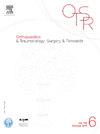继腰骶部融合术之后的微创骶髂关节融合术:随访两年的临床和功能结果。
IF 2.3
3区 医学
Q2 ORTHOPEDICS
引用次数: 0
摘要
简介众所周知,退行性骶髂关节(SI)综合征在腰骶部融合术后更为常见。虽然这种诊断是根据各种临床标准和诊断测试来怀疑的,但需要通过诊断性神经阻滞来确诊。如果保守治疗无效,通过微创方法进行 SI 关节融合术对处于治疗十字路口的患者来说是一种有效的缓解方法。本研究旨在评估腰骶椎融合术后 SI 关节综合征患者微创 SI 关节融合术后 2 年的临床和功能效果:我们对2017年6月至2020年10月期间接受手术的患者进行了单中心回顾性研究。研究对象包括腰骶部融合术后确诊为SI关节综合征、接受SI关节融合术且随访至少2年的患者。主要结果是腰痛和根性疼痛的改善程度,采用数字评分量表(NRS)进行评分。次要结果是功能评分(Oswestry 和 SF-12)以及患者满意度。我们的研究对象包括 54 名患者(41 名女性,13 名男性),平均年龄为 59 岁(27-88 岁)。其中 31 名患者接受了双侧手术(共 85 例融合术)。在进行腰椎间盘融合术之前,患者平均接受过 3 次腰椎手术(1-7 次):结果:腰椎和根性 NRS 在术前分别为 8.4(7-10)和 5.1(2-10),术后 2 年分别为 5.2(0-8)和 3.0(0-8),分别降低了 37% 和 42%(p 讨论:本研究中的患者在接受微创 SI 关节融合术后,临床和功能均有明显改善。以前发表的分析 SI 关节融合术结果的文章发现,患者的改善程度更大,但这些患者的病因相对不同;在我们的研究中,只纳入了有腰骶部融合术病史的患者:结论:微创SI关节融合术有助于腰骶部融合术后出现SI关节综合征的患者改善临床和功能:IV,回顾性研究。本文章由计算机程序翻译,如有差异,请以英文原文为准。
Minimally invasive sacroiliac joint fusion secondary to lumbosacral fusion: Clinical and functional results at 2 years of follow-up
Introduction
Degenerative sacroiliac (SI) joint syndrome is known to be more common after lumbosacral fusion. While this diagnosis is suspected based on various clinical criteria and diagnostic tests, it is confirmed with a diagnostic nerve block. If conservative treatment fails, SI joint fusion through a minimally invasive approach is a useful palliative approach for patients at a treatment crossroads. The aim of this study was to evaluate the clinical and functional results at 2 years postoperative after minimally invasive SI joint fusion in patients with SI joint syndrome following lumbosacral fusion.
Materials and methods
We carried out a single-center retrospective study of patients operated between June 2017 and October 2020. Included were patients who had a confirmed diagnosis of SI joint syndrome after lumbosacral fusion surgery, who underwent SI joint fusion and had at least 2 years’ follow-up. The primary outcome was the improvement in lumbar and radicular pain on a numerical rating scale (NRS). The secondary outcomes were the functional scores (Oswestry and SF-12) along with the level of patient satisfaction. Our study population consisted of 54 patients (41 women, 13 men) with a mean age of 59 years (27–88). Thirty-one of these patients were operated on both sides (85 fusions in all). The patients had undergone a mean of 3 lumbar surgeries (1–7) before the SI fusion.
Results
The lumbar and radicular NRS were 8.4 (7–10) and 5.1 (2–10) preoperatively and 5.2 (0–8) and 3.0 (0–8) at 2 years postoperatively, which was a reduction of 37% and 42% (p < 0.001), respectively. The Oswestry score went from 69.4 (52–86) preoperatively to 45.6 (29–70) at 2 years, which was a 33% improvement (p < 0.001). Eighty-six percent of patients were satisfied or very satisfied with the surgery.
Discussion
After minimally invasive SI joint fusion, the patients in this study had clear clinical and functional improvements. Previous publications analyzing the results of SI joint fusion found even more improvement, but those patients were relatively heterogenous; in our study, only patients who had a history of lumbosacral fusion were included.
Conclusion
Minimally invasive SI joint fusion helped patients who developed SI joint syndrome after lumbosacral fusion to improve clinically and functionally.
Level of evidence
IV, retrospective study.
求助全文
通过发布文献求助,成功后即可免费获取论文全文。
去求助
来源期刊
CiteScore
5.10
自引率
26.10%
发文量
329
审稿时长
12.5 weeks
期刊介绍:
Orthopaedics & Traumatology: Surgery & Research (OTSR) publishes original scientific work in English related to all domains of orthopaedics. Original articles, Reviews, Technical notes and Concise follow-up of a former OTSR study are published in English in electronic form only and indexed in the main international databases.

 求助内容:
求助内容: 应助结果提醒方式:
应助结果提醒方式:


